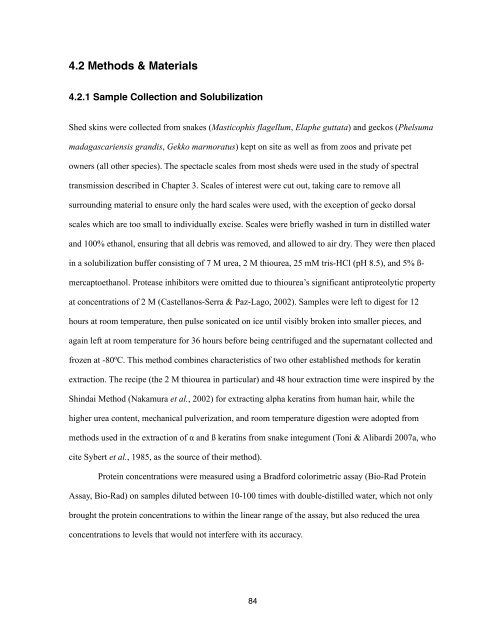Chapter 1, The Reptilian Spectacle - UWSpace - University of ...
Chapter 1, The Reptilian Spectacle - UWSpace - University of ...
Chapter 1, The Reptilian Spectacle - UWSpace - University of ...
Create successful ePaper yourself
Turn your PDF publications into a flip-book with our unique Google optimized e-Paper software.
4.2 Methods & Materials<br />
4.2.1 Sample Collection and Solubilization<br />
Shed skins were collected from snakes (Masticophis flagellum, Elaphe guttata) and geckos (Phelsuma<br />
madagascariensis grandis, Gekko marmoratus) kept on site as well as from zoos and private pet<br />
owners (all other species). <strong>The</strong> spectacle scales from most sheds were used in the study <strong>of</strong> spectral<br />
transmission described in <strong>Chapter</strong> 3. Scales <strong>of</strong> interest were cut out, taking care to remove all<br />
surrounding material to ensure only the hard scales were used, with the exception <strong>of</strong> gecko dorsal<br />
scales which are too small to individually excise. Scales were briefly washed in turn in distilled water<br />
and 100% ethanol, ensuring that all debris was removed, and allowed to air dry. <strong>The</strong>y were then placed<br />
in a solubilization buffer consisting <strong>of</strong> 7 M urea, 2 M thiourea, 25 mM tris-HCl (pH 8.5), and 5% ß-<br />
mercaptoethanol. Protease inhibitors were omitted due to thiourea’s significant antiproteolytic property<br />
at concentrations <strong>of</strong> 2 M (Castellanos-Serra & Paz-Lago, 2002). Samples were left to digest for 12<br />
hours at room temperature, then pulse sonicated on ice until visibly broken into smaller pieces, and<br />
again left at room temperature for 36 hours before being centrifuged and the supernatant collected and<br />
frozen at -80ºC. This method combines characteristics <strong>of</strong> two other established methods for keratin<br />
extraction. <strong>The</strong> recipe (the 2 M thiourea in particular) and 48 hour extraction time were inspired by the<br />
Shindai Method (Nakamura et al., 2002) for extracting alpha keratins from human hair, while the<br />
higher urea content, mechanical pulverization, and room temperature digestion were adopted from<br />
methods used in the extraction <strong>of</strong> α and ß keratins from snake integument (Toni & Alibardi 2007a, who<br />
cite Sybert et al., 1985, as the source <strong>of</strong> their method).<br />
Protein concentrations were measured using a Bradford colorimetric assay (Bio-Rad Protein<br />
Assay, Bio-Rad) on samples diluted between 10-100 times with double-distilled water, which not only<br />
brought the protein concentrations to within the linear range <strong>of</strong> the assay, but also reduced the urea<br />
concentrations to levels that would not interfere with its accuracy.<br />
84
















